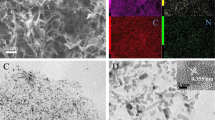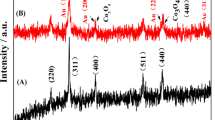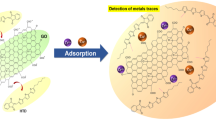Abstract
A label-free and efficient electrochemical (EC) sensing platform for di-2-ethylhexyl phthalate (DEHP) was developed based on in situ probe nickel hexacyanoferrate nanoparticle (NiHCF NP)-decorated three-dimensional reduced graphene oxide (3D rGO) composites. NiHCF NPs in the composites as an in situ probe show a pair of well-defined peaks with good reversibility and stability. Coupling 3D rGO with NiHCF NPs not only improved the electron transfer capability of NiHCF NPs but also provided more sites for aptamer immobilization. The synthesized NiHCF NP-decorated 3D rGO composites were used to act as a substrate for the immobilization of anti-DEHP aptamer by the covalent bonding method. The designed EC sensing platform displays excellent sensing performance for DEHP with a low detection limit of 3.64 pg/L, and a linear working range of 0.01 − 1000 ng/L. The application of the sensing platform to actual environmental samples was studied and satisfactory results were obtained. Thus, the proposed EC sensing platform would provide a potential tool for efficient detection of pollutants in the environment.
Graphical abstract









Similar content being viewed by others
References
Xu H, Zhu JH, Cheng YX et al (2021) Functionalized UIO-66@Ag nanoparticles substrate for rapid and ultrasensitive SERS detection of di-(2-ethylhexyl) phthalate in plastics. Sens Actuators B 349:130793. https://doi.org/10.1016/j.snb.2021.130793
Dai XY, Zhu SY, Chen J et al (2022) Role of toll-like receptor/MyD88 signaling in lycopene alleviated di-2-ethylhexyl phthalate (DEHP)-induced inflammatory response. J Agric Food Chem 70:10022–10030. https://doi.org/10.1021/acs.jafc.2c03864
Boaretti C, Donadini R, Roso M et al (2021) Transesterification of bis(2-ethylhexyl) phthalate for the recycling of flexible polyvinyl chloride scraps in the circular economy framework. Ind Eng Chem Res 60:17750–17760. https://doi.org/10.1021/acs.iecr.1c03639
Chen Q, Du MJ, Xu XQ (2022) A label-free and selective electrochemical aptasensor for ultrasensitive detection of Di(2-ethylhexyl) phthalate based on self-assembled DNA nanostructure amplification. J Electroanal Chem 914:116300. https://doi.org/10.1016/j.jelechem.2022.116300
Zota AR, Calafat AM, Woodruff TJ (2014) Temporal trends in phthalate exposures: findings from the national health and nutrition examination survey, 2001–2010. Environ Health Perspect 122:235–241. https://doi.org/10.1289/ehp.1306681
Ge J, Guo K, Zhang C et al (2021) Comparison of nanoparticle-selenium, selenium-enriched yeast and sodium selenite on the alleviation of cadmium-induced inflammation via NF-kB/I kappa B pathway in heart. Sci Total Environ 773:145442. https://doi.org/10.1016/j.scitotenv.2021.145442
Dai XY, Zhao Y, Ge J et al (2021) Lycopene attenuates di(2-ethylhexyl) phthalate-induced mitophagy in spleen by regulating the sirtuin3-mediated pathway. Food Funct 12:4582–4590. https://doi.org/10.1039/D0FO03277H
Tahmasebi E, Masoomi MY, Yaminia Y, Morsali A (2016) Application of a Zn (II) based metal-organic framework as an efficient solid-phase extraction sorbent for preconcentration of plasticizer compounds. RSC Adv 46:40211–40218. https://doi.org/10.1039/C6RA06560K
Sargazi S, Mirzaei R, Rahmani M et al (2017) One-step in-syringe dispersive liquid-liquid microextraction an GC-FID determination of trace amounts of di(2-ethylhexyl) phthalate and its metabolite in human urine samples. J Anal Chem 72:557–561. https://doi.org/10.1134/S1061934817050100
Ozer ET, Osman B, Yazici T (2017) Dummy molecularly imprinted microbeads as solid-phase extraction material for selective determination of phthalate esters in water. J Chromatogr A 1500:53–60. https://doi.org/10.1016/j.chroma.2017.04.013
Xu YY, Weng R, Lu YS et al (2018) Evaluation of phthalic acid esters in fish samples using gas chromatography tandem mass spectrometry with simplified QuEChERS technique. Food Anal Methods 11:3293–3303. https://doi.org/10.1007/s12161-018-1313-z
Makkliang F, Kanatharana P, Thavarungkul P, Thammakhet-Buranachai C (2017) A polypyrrole-chitosan cryogel stir-bead micro-solid phase extractor for the determination of phthalate esters in contact lenses storage solutions and in artificial saliva in contact with baby teethers. Anal Chim Acta 985:69–78. https://doi.org/10.1016/j.aca.2017.06.050
Cheng LD, Pan SH, Ding CY et al (2017) Dispersive solid-phase microextraction with graphene oxide based molecularly imprinted polymers for determining bis(2-ethylhexyl) phthalate in environmental water. J Chromatogr A 1511:85–91. https://doi.org/10.1016/j.chroma.2017.07.012
Sun RY, Zhuang HS (2014) A sensitive heterogeneous biotin-streptavidin enzyme-linked immunosorbent assay for the determination of di-2-ethylhexyl phthalate (DEHP) in beverages using a specific polyclonal antibody. Anal Methods 6:9807–9815. https://doi.org/10.1039/c4ay02088j
Yang YY, Li YT, Zhai WL et al (2021) Electrokinetic preseparation and molecularly imprinted trapping for highly selective SERS detection of charged phthalate plasticizers. Anal Chem 93:946–955. https://doi.org/10.1021/acs.analchem.0c03652
Li HY, Li Q, Zhao SX et al (2022) Aptamer-target recognition-promoted ratiometric electrochemical strategy for evaluating the microcystin-LR residue in fish without interferences. J Agric Food Chem 70:680–686. https://doi.org/10.1021/acs.jafc.1c06476
Ranjan P, Sadique MA, Yadav S, Khan R (2022) An electrochemical immunosensor based on gold-graphene oxide nanocomposites with ionic liquid for detecting the breast cancer CD44 biomarker. ACS Appl Mater Interfaces 14:20802–20812. https://doi.org/10.1021/acsami.2c03905
Xiong SQ, Cheng JJ, He LL et al (2014) Detection of di (2-ethylhexyl) phthalate through graphene-beta-cyclodextrin composites by electrochemical impedance spectroscopy. Anal Methods 6:1736–1742. https://doi.org/10.1039/c3ay42039f
Liu X, Liu P, Tang Y et al (2018) A photoelectrochemical aptasensor based on a 3D flower-like TiO2-MoS2-Gold nanoparticle heterostructure for detection of kanamycin. Biosens Bioelectron 112:193–201. https://doi.org/10.1016/j.bios.2018.04.041
Lim HJ, Kim AR, Yoon MY et al (2018) Development of quantum dot aptasensor and its portable analyzer for the detection of di-2-ethylhexyl phthalate. Biosens Bioelectron 121:1–9. https://doi.org/10.1016/j.bios.2018.08.065
Li YY, Liu D, Meng SY et al (2021) Regulation of Ru(bpy)32+ electrochemiluminescence based on distance-dependent electron transfer of ferrocene for dual-signal readout detection of aflatoxin B1 with high sensitivity. Anal Chem 94:1294–1301. https://doi.org/10.1021/acs.analchem.1c04501
Wang HY, Wang F, Wu T, Liu Y (2021) Highly active electrochemiluminescence of ruthenium complex Co-assembled chalcogenide nanoclusters and the application for label-free detection of alkaline phosphatase. Anal Chem 93:15794–15801. https://doi.org/10.1021/acs.analchem.1c04130
Qi HJ, Li HY, Li F (2021) Aptamer recognition-driven homogeneous electrochemical strategy for simultaneous analysis of multiple pesticides without interference of color and fluorescence. Anal Chem 93:7739–7745. https://doi.org/10.1021/acs.analchem.1c01252
Karki SB, Hona RK, Yu M, Ramezanipour F (2022) Enhancement of electrocatalytic activity as a function of structural order in perovskite oxides. ACS Catal 12:10333–10337. https://doi.org/10.1021/acscatal.2c02411
Komarala EP, Neethinathan CSS, Kokkiligadda S et al (2022) DNA scaffolds with manganese oxide/oxyhydroxide nanoparticles for highly stable supercapacitance electrodes. ACS Appl Nano Mater 5:8902–8912. https://doi.org/10.1021/acsanm.2c01091
Li C, Jiang HM, Liu PX et al (2022) One porphyrin per chain self-assembled helical ion-exchange channels for ultrahigh osmotic energy conversion. J Am Chem Soc 144:9472–9478. https://doi.org/10.1021/jacs.2c02798
Zhao FL, Feng YY, Wang Y et al (2020) Two-dimensional gersiloxenes with tunable bandgap for photocatalytic H2 evolution and CO2 photoreduction to CO. Nat Commun 11:1443. https://doi.org/10.1038/s41467-020-15262-4
Huang HB, Shi HD, Das P et al (2020) The chemistry and promising applications of graphene and porous graphene materials. Adv Funct Mater 30:1909035. https://doi.org/10.1002/adfm.201909035
Sun ZX, Fang SY, Hu YH (2020) 3D graphene materials: from understanding to design and synthesis control. Chem Rev 120:10336–10453. https://doi.org/10.1021/acs.chemrev.0c00083
Marcano DC, Kosynkin DV, Berlin JM et al (2010) Correction to: improved synthesis of graphene oxide. ACS Nano 4:4806–4814. https://doi.org/10.1021/nn1006368
Devi R, Gogoi S, Barua S et al (2019) Electrochemical detection of monosodium glutamate in foodstuffs based on Au@MoS2/chitosan modified glassy carbon electrode. Food Chem 276:350–357. https://doi.org/10.1016/j.foodchem.2018.10.024
Chen J, Huang KL, Liu SQ, Hu X (2009) Electrochemical supercapacitor behavior of Ni3(Fe(CN)6)2(H2O) nanoparticles. J Power Sources 186:565–569. https://doi.org/10.1016/j.jpowsour.2008.08.071
Fan LF, Wang GZ, Liang WT et al (2019) Label-free and highly selective electrochemical aptasensor for detection of PCBs based on nickel hexacyanoferrate nanoparticles/reduced graphene oxides hybrids. Biosens Bioelectron 145:111728. https://doi.org/10.1016/j.bios.2019.111728
Deng Y, Yan WN, Guo YJ et al (2022) Highly sensitive and selective photoelectrochemical aptasensing of di-2-ethylhexyl phthalate based on graphene quantum dots decorated TiO2 nanotube arrays. J Hazard Mater 426:128107. https://doi.org/10.1016/j.jhazmat.2021.128107
Lee K, Gurudatt NG, Heo W et al (2022) Ultrasensitive detection and risk assessment of di (2-ethylhexyl) phthalate migrated from daily-use plastic products using a nanostructured electrochemical aptasensor. Sens Actuators B 357:131381. https://doi.org/10.1016/j.snb.2022.131381
Fan Z, Fan L, Shuang S, Dong C (2018) Highly sensitive photoelectrochemical sensing of bisphenol A based on zinc phthalocyanine/TiO2 nanorod arrays. Talanta 189:16–23. https://doi.org/10.1016/j.talanta.2018.06.043
Funding
This work is financially supported by the National Natural Science Foundation of China (Grant 22076107, 21707082, and 21775095), the Natural Science Foundation of Shanxi Province (20210302124342), the Hundred Talent Program of Shanxi Province, Shanxi Laboratory for Yellow River, and the Foundation of State Key Laboratory of High-efficiency Utilization of Coal and Green Chemical Engineering.
Author information
Authors and Affiliations
Corresponding authors
Ethics declarations
Conflict of interest
The authors declare no competing interests.
Additional information
Publisher's note
Springer Nature remains neutral with regard to jurisdictional claims in published maps and institutional affiliations.
Supplementary information
Below is the link to the electronic supplementary material.
Rights and permissions
Springer Nature or its licensor (e.g. a society or other partner) holds exclusive rights to this article under a publishing agreement with the author(s) or other rightsholder(s); author self-archiving of the accepted manuscript version of this article is solely governed by the terms of such publishing agreement and applicable law.
About this article
Cite this article
Liu, Y., Deng, Y., Liao, D. et al. Nickel hexacyanoferrate nanoparticle-decorated 3D rGO composites-based electrochemical sensing platform for detection of di-2-ethylhexyl phthalate. Microchim Acta 190, 107 (2023). https://doi.org/10.1007/s00604-023-05670-w
Received:
Accepted:
Published:
DOI: https://doi.org/10.1007/s00604-023-05670-w




